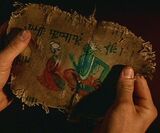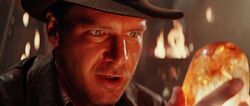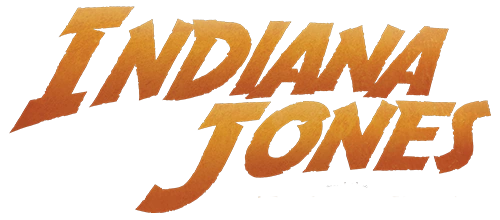m (Reverted edits by 2601:182:4202:2D92:FCE9:6EFC:2885:789E (talk) to last version by Vetinari) |
Tag: Visual edit |
||
| (5 intermediate revisions by 3 users not shown) | |||
| Line 8: | Line 8: | ||
|discoverer= |
|discoverer= |
||
|collector=One returned to [[Mayapore]] |
|collector=One returned to [[Mayapore]] |
||
| ⚫ | |||
| − | }} |
||
| ⚫ | |||
==History== |
==History== |
||
| Line 15: | Line 14: | ||
According to legend, five stones were given to [[Sankara]] by the Hindu god [[Shiva]] on [[Mount Kalisa]], along with the message that he should go forth and battle evil with them. The stones contained diamonds inside, which would glow when the stones were brought together, as a way to recount the legend of Shiva emerging from the fiery pillar. The diamonds could give warmth and life, but the stones could also be used for fiery destruction for those who betrayed Shiva.<ref>''[[The Lost Journal of Indiana Jones]]''</ref> |
According to legend, five stones were given to [[Sankara]] by the Hindu god [[Shiva]] on [[Mount Kalisa]], along with the message that he should go forth and battle evil with them. The stones contained diamonds inside, which would glow when the stones were brought together, as a way to recount the legend of Shiva emerging from the fiery pillar. The diamonds could give warmth and life, but the stones could also be used for fiery destruction for those who betrayed Shiva.<ref>''[[The Lost Journal of Indiana Jones]]''</ref> |
||
| − | Sankara used the stones to convert many in [[India]] to the worship of Shiva. After his death, however, the stones became lost, scattered by wars and sold on by mercenaries over hundreds of years. |
+ | Sankara used the stones to convert many in [[India]] to the worship of Shiva. After his death, however, the stones became lost, scattered by wars and sold on by mercenaries over hundreds of years. By the 1930s, two of these "Sankara Stones" sat buried underground beneath the [[Pankot Palace|palace]] of [[Pankot]] while a second pair managed to fall into the possession of a [[Thuggee]] high priest's son by the name of [[Mola Ram]].<ref name="IJ: TUG">''[[Indiana Jones: The Ultimate Guide]]''</ref> |
| ⚫ | The last of the five had ended up in a small village called [[Mayapore]] located in northern India. It was found in a river and revered by the people of Mayapore because it brought happiness and prosperity to the village. They called it '''Sivalinga''' or '''Shivalinga''', and it served as the town's lingam. It had three notches on the side, representing the three levels of the universe according to their beliefs.<ref name="IJatToD">''[[Indiana Jones and the Temple of Doom]]''</ref> |
||
| − | By the 1930s, two of these "Sankara Stones" sat buried underground beneath the [[Pankot Palace|palace]] of [[Pankot]] while a second pair managed to fall into the possession of a [[Thuggee]] high priest's son by the name of [[Mola Ram]]. |
||
| ⚫ | Sivalinga was taken from Mayapore by members of the evil Thuggee cult, under the command of Mola Ram, who also kidnapped Mayapore's children. Without the stone, life in Mayapore withered and died. In [[1935]], [[Indiana Jones]] – who had recently survived a plane crash – ended up at the village, and was sent to recover the stone at the behest of Mayapore's shaman, [[Marhan]], and its [[chieftain]]. The Thuggee priest Mola Ram had brought his two and Sivalinga to Pankot, and set them in an [[Temple of Doom|underground temple]] dedicated to the goddess [[Kali]], located below Pankot Palace. With the final two stones lying in the caverns below the palace, Mola Ram forced the kidnapped children to work in a mine to locate the last two stones, believing that with the power of the stones, Kali Ma would rule the world.<ref name="IJatToD" /> |
||
| ⚫ | The last of the five had ended up in a small village called [[Mayapore]] located in northern India. It was found in a river and revered by the people of Mayapore because it brought happiness and prosperity to the village. They called it '''Sivalinga''' or '''Shivalinga''', and it served as the town's lingam. It had three notches on the side, representing the three levels of the universe according to their beliefs. |
||
| − | |||
| ⚫ | Sivalinga was taken from Mayapore by members of the evil Thuggee cult, under the command of Mola Ram, who also kidnapped Mayapore's children. Without the stone, life in Mayapore withered and died. In [[1935]], [[Indiana Jones]] – who had recently survived a plane crash – ended up at the village, and was sent to recover the stone at the behest of Mayapore's shaman, [[Marhan]], and its [[chieftain]]. The Thuggee priest Mola Ram had brought his two and Sivalinga to Pankot, and set them in an [[Temple of Doom|underground temple]] dedicated to the goddess [[Kali]], located below Pankot Palace. With the final two stones lying in the caverns below the palace, Mola Ram forced the kidnapped children to work in a mine to locate the last two stones, believing that with the power of the stones, Kali Ma would rule the world. |
||
[[File:Stones.jpg|thumb|right|250px|Indiana Jones claims the Sankara Stones from the Temple of Doom]] |
[[File:Stones.jpg|thumb|right|250px|Indiana Jones claims the Sankara Stones from the Temple of Doom]] |
||
| − | The three located stones were placed in the alcoves of a large statue inside the temple, until stolen by Indiana Jones. While escaping the mines with the three stones, Jones was pursued by the Thuggee to a rope bridge located over a large chasm. Grappling with Ram for the stones, Jones began incanting in Sanskrit. The Sankara Stones responded and burned a hole through Jones' satchel. Two of them plummeted down into the [[crocodile]]-filled waters below but as Sivalinga broke free of the bag, Ram grabbed it before it was lost. It's holy glow was too painful for Ram to bear, however, and he fell to his death while Jones caught the stone. Instead of claiming it for himself, Jones decided that its home was back in Mayapore and he returned it to Marhan. |
+ | The three located stones were placed in the alcoves of a large statue inside the temple, until stolen by Indiana Jones. While escaping the mines with the three stones, Jones was pursued by the Thuggee to a rope bridge located over a large chasm. Grappling with Ram for the stones, Jones began incanting in Sanskrit. The Sankara Stones responded and burned a hole through Jones' satchel. Two of them plummeted down into the [[crocodile]]-filled waters below but as Sivalinga broke free of the bag, Ram grabbed it before it was lost. It's holy glow was too painful for Ram to bear, however, and he fell to his death while Jones caught the stone. Instead of claiming it for himself, Jones decided that its home was back in Mayapore and he returned it to [[Marhan]].<ref name="IJatToD" /> |
| − | Unbeknownst to Jones or the Thuggee, the remaining two Sankara stones sat just a few feet away from an excavated area in the mine's wall.<ref |
+ | Unbeknownst to Jones or the surviving Thuggee, the remaining two Sankara stones sat just a few feet away from an excavated area in the mine's wall.<ref name="IJ: TUG" /> |
| + | |||
| + | ==Behind the scenes== |
||
| + | In ''[[Indiana Jones and the Temple of Doom]]'', while fighting with [[Mola Ram]] for the possession of the Sankara Stones, [[Indiana Jones]] gets the stones to turn red hot by uttering "Tum Shiva ke vishwaas-ghati ho!", which is Hindi for "You are a betrayer of [[Shiva]]". |
||
| + | |||
| + | In 2018, gem miner and mineral aficionado Erik Rintamaki discovered a type of florescent rock in [[Michigan]] that he named "Yooperlite" (after the nickname for the people who live in the US state's upper peninsula). The website [[Wikipedia:Nerdist Industries|Nerdist]], seeing the Yooperlites' similarity to the Sankara Stones, joked that scientists would be unable to say whether or not the rocks could be used to go forth and battle evil..<ref>[https://nerdist.com/glowing-rocks-indiana-jones-temple-of-doom/ THESE GLOWING ROCKS LOOK LIKE SOMETHING OUT OF INDIANA JONES] at [https://nerdist.com Nerdist]</ref> |
||
==Appearances== |
==Appearances== |
||
| Line 34: | Line 36: | ||
*[[Indiana Jones and the Temple of Doom (junior novelization)|''Indiana Jones and the Temple of Doom'' junior novel]] |
*[[Indiana Jones and the Temple of Doom (junior novelization)|''Indiana Jones and the Temple of Doom'' junior novel]] |
||
*[[Indiana Jones and the Temple of Doom (comic)|''Indiana Jones and the Temple of Doom'' comic]] |
*[[Indiana Jones and the Temple of Doom (comic)|''Indiana Jones and the Temple of Doom'' comic]] |
||
| + | |||
| ⚫ | |||
| + | === Non-canonical appearances === |
||
| + | |||
| ⚫ | |||
| + | *''[[LEGO Indiana Jones: The Original Adventures]]'' |
||
| + | *''[[LEGO Indiana Jones 2: The Adventure Continues]]'' |
||
==Sources== |
==Sources== |
||
*''[[From Star Wars To Indiana Jones - The Best of the Lucasfilm Archives]]'' |
*''[[From Star Wars To Indiana Jones - The Best of the Lucasfilm Archives]]'' |
||
*{{IJ|url=marshall/artifact/sankarastones/|text={{PAGENAME}}}} |
*{{IJ|url=marshall/artifact/sankarastones/|text={{PAGENAME}}}} |
||
| + | *{{IJ|url=marshall/character/shortround/|text=Short Round's Marshall College entry}} |
||
*''[[Indiana Jones: The Ultimate Guide]]'' |
*''[[Indiana Jones: The Ultimate Guide]]'' |
||
*''[[Indiana Jones: The Official Magazine 3]]'' |
*''[[Indiana Jones: The Official Magazine 3]]'' |
||
Revision as of 14:55, 29 September 2021
The Sankara Stones were five smooth-polished stones shaped like lingams, rounded columns used as a symbol of the fertility aspect of Shiva.
History

A cloth depicting Sankara and Shiva.
According to legend, five stones were given to Sankara by the Hindu god Shiva on Mount Kalisa, along with the message that he should go forth and battle evil with them. The stones contained diamonds inside, which would glow when the stones were brought together, as a way to recount the legend of Shiva emerging from the fiery pillar. The diamonds could give warmth and life, but the stones could also be used for fiery destruction for those who betrayed Shiva.[1]
Sankara used the stones to convert many in India to the worship of Shiva. After his death, however, the stones became lost, scattered by wars and sold on by mercenaries over hundreds of years. By the 1930s, two of these "Sankara Stones" sat buried underground beneath the palace of Pankot while a second pair managed to fall into the possession of a Thuggee high priest's son by the name of Mola Ram.[2]
The last of the five had ended up in a small village called Mayapore located in northern India. It was found in a river and revered by the people of Mayapore because it brought happiness and prosperity to the village. They called it Sivalinga or Shivalinga, and it served as the town's lingam. It had three notches on the side, representing the three levels of the universe according to their beliefs.[3]
Sivalinga was taken from Mayapore by members of the evil Thuggee cult, under the command of Mola Ram, who also kidnapped Mayapore's children. Without the stone, life in Mayapore withered and died. In 1935, Indiana Jones – who had recently survived a plane crash – ended up at the village, and was sent to recover the stone at the behest of Mayapore's shaman, Marhan, and its chieftain. The Thuggee priest Mola Ram had brought his two and Sivalinga to Pankot, and set them in an underground temple dedicated to the goddess Kali, located below Pankot Palace. With the final two stones lying in the caverns below the palace, Mola Ram forced the kidnapped children to work in a mine to locate the last two stones, believing that with the power of the stones, Kali Ma would rule the world.[3]

Indiana Jones claims the Sankara Stones from the Temple of Doom
The three located stones were placed in the alcoves of a large statue inside the temple, until stolen by Indiana Jones. While escaping the mines with the three stones, Jones was pursued by the Thuggee to a rope bridge located over a large chasm. Grappling with Ram for the stones, Jones began incanting in Sanskrit. The Sankara Stones responded and burned a hole through Jones' satchel. Two of them plummeted down into the crocodile-filled waters below but as Sivalinga broke free of the bag, Ram grabbed it before it was lost. It's holy glow was too painful for Ram to bear, however, and he fell to his death while Jones caught the stone. Instead of claiming it for himself, Jones decided that its home was back in Mayapore and he returned it to Marhan.[3]
Unbeknownst to Jones or the surviving Thuggee, the remaining two Sankara stones sat just a few feet away from an excavated area in the mine's wall.[2]
Behind the scenes
In Indiana Jones and the Temple of Doom, while fighting with Mola Ram for the possession of the Sankara Stones, Indiana Jones gets the stones to turn red hot by uttering "Tum Shiva ke vishwaas-ghati ho!", which is Hindi for "You are a betrayer of Shiva".
In 2018, gem miner and mineral aficionado Erik Rintamaki discovered a type of florescent rock in Michigan that he named "Yooperlite" (after the nickname for the people who live in the US state's upper peninsula). The website Nerdist, seeing the Yooperlites' similarity to the Sankara Stones, joked that scientists would be unable to say whether or not the rocks could be used to go forth and battle evil..[4]
Appearances
- Indiana Jones and the Temple of Doom (First appearance)
- Indiana Jones and the Temple of Doom novel
- Indiana Jones and the Temple of Doom junior novel
- Indiana Jones and the Temple of Doom comic
Non-canonical appearances
- LEGO Indiana Jones Adventures: Shanghai Chase
- LEGO Indiana Jones: The Original Adventures
- LEGO Indiana Jones 2: The Adventure Continues
Sources
- From Star Wars To Indiana Jones - The Best of the Lucasfilm Archives
Sankara Stones on IndianaJones.com (backup link on Archive.org)
Short Round's Marshall College entry on IndianaJones.com (backup link on Archive.org)
- Indiana Jones: The Ultimate Guide
- Indiana Jones: The Official Magazine 3
- The Lost Journal of Indiana Jones
- The Greatest Adventures of Indiana Jones
